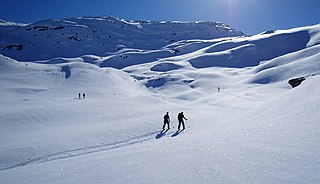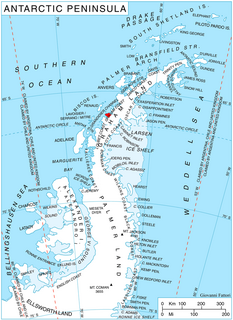
Cross-country skiing is a form of skiing where skiers rely on their own locomotion to move across snow-covered terrain, rather than using ski lifts or other forms of assistance. Cross-country skiing is widely practiced as a sport and recreational activity; however, some still use it as a means of transportation. Variants of cross-country skiing are adapted to a range of terrain which spans unimproved, sometimes mountainous terrain to groomed courses that are specifically designed for the sport.

Skiing is a means of transport using skis to glide on snow. Variations of purpose include basic transport, a recreational activity, or a competitive winter sport. Many types of competitive skiing events are recognized by the International Olympic Committee (IOC), and the International Ski Federation (FIS).

Alpine skiing, or downhill skiing, is the pastime of sliding down snow-covered slopes on skis with fixed-heel bindings, unlike other types of skiing, which use skis with free-heel bindings. Whether for recreation or for sport, it is typically practised at ski resorts, which provide such services as ski lifts, artificial snow making, snow grooming, restaurants, and ski patrol.

Telemark skiing is a skiing technique that combines elements of Alpine and Nordic skiing. Telemark skiing is named after the Telemark region of Norway, where the discipline originated. Sondre Norheim is often credited for first demonstrating the turn in ski races, which included cross country, slalom and jumping, in Norway around 1868. Sondre Norheim also experimented with ski and binding design, introducing side cuts to skis and heel bindings.

Ski mountaineering is a skiing discipline that involves climbing mountains either on skis or carrying them, depending on the steepness of the ascent, and then descending on skis. There are two major categories of equipment used, free-heel Telemark skis and skis based on Alpine skis, where the heel is free for ascents, but is fixed during descent. The discipline may be practiced recreationally or as a competitive sport.
The Crazy Canucks was a group of World Cup alpine ski racers from Canada who rose to prominence in the 1970s and 1980s. Jungle Jim Hunter, Dave Irwin, Dave Murray, Steve Podborski, and Ken Read earned themselves a reputation for fast and seemingly reckless skiing in the downhill event.
Skin Graft Records is an independent record label specializing in no wave and noise rock, originally based in Chicago, Illinois. The label is largely responsible for spawning "now wave" genre, an updated version of the late 1970s/early 1980s no wave movement.

Sundance Resort, also known as Sundance Mountain Resort, is a ski resort located 13 miles (21 km) northeast of Provo, Utah. It spans over 5,000 acres (2,000 ha) on the slopes of Mount Timpanogos in Utah's Wasatch Range. Alpine skiing began on the site in 1944. Actor Robert Redford acquired the area in 1968, and established a year-round resort which would later spawn the independent Sundance Film Festival and the non-profit Sundance Institute. Sundance is committed to the balance of art, nature and community.

Ski touring is skiing in the backcountry on unmarked or unpatrolled areas. Touring is typically done off-piste and outside of ski resorts, and may extend over a period of more than one day. It is similar to backcountry skiing.

Backcountry skiing (US), also called off-piste (Europe), alpine touring, or out-of-area, is skiing in the backcountry on unmarked or unpatrolled areas either inside or outside a ski resort's boundaries. This contrasts with alpine skiing which is typically done on groomed trails benefiting from a ski patrol. Unlike ski touring, backcountry skiing can include the use of ski lifts including snowcats and helicopters. Recent improvements in equipment have increased the popularity of the sport.

A rash guard, also known as rash vest or rashie, is an athletic shirt made of spandex and nylon or polyester. The name rash guard reflects the fact that the shirt protects the wearer against rashes caused by abrasion, or by sunburn from extended exposure to the sun. These shirts can be worn by themselves, or under a wetsuit. A rash guard by itself is used for light coverage in warm to extreme summer temperatures for several watersports including surfing, canoe polo, water survival training, scuba diving, snorkeling, freediving, wakeboarding, bodysurfing, bodyboarding, windsurfing, kitesurfing, kayaking, stand up paddle surfing, or swimming. There are also lower body rash guards, which are similar to compression shorts to be worn under the surfers' boardshorts, but more specialized for surfers.

Suzanne Stevia "Suzy" Chaffee is a former Olympic alpine ski racer and actress. Following her racing career, she modeled in New York with Ford Models and then became the pre-eminent freestyle ballet skier of the early 1970s. She is perhaps best known by the nickname, Suzy Chapstick, from the 1970s, when she was a spokesperson for ChapStick lip balm.

Firbank Grammar School is an independent, Anglican, day and boarding school, situated in the suburb of Brighton, in the bayside area of Melbourne, Australia.

Sascha Ring, better known by the stage name Apparat, is a German electronic musician. He was previously co-owner of Shitkatapult records. Starting out with dancefloor-oriented techno, he shifted focus towards ambient music, becoming "more interested in designing sounds than beats".

Sportswear or activewear is clothing, including footwear, worn for sport or physical exercise. Sport-specific clothing is worn for most sports and physical exercise, for practical, comfort or safety reasons.

Easy to Love is a 1953 Technicolor musical film directed by Charles Walters. It stars Esther Williams and Van Johnson. It was Williams' final aquatic film with a U.S. setting.

Sohm Glacier is a glacier flowing into Bilgeri Glacier on Velingrad Peninsula, the west coast of Graham Land. Charted by the British Graham Land Expedition (BGLE) under Rymill, 1934-37. Named by the United Kingdom Antarctic Place-Names Committee (UK-APC) in 1959 for Victor Sohm, Austrian skiing exponent who invented a special type of ski skins and ski wax.

Snow Job is a 1972 American independent thriller film directed by George Englund and starring Jean-Claude Killy, Danièle Gaubert, and Cliff Potts.

Climbing skins are strips that attach to the bottom of nordic, alpine touring or randonnée skis to help while ascending backcountry slopes. They are designed to be removed for skiing downhill. They are typically attached to the skis via a loop on the ski tip, a hook on the tail, and adhesive on the base of the skin. They are called skins because they resemble sealskin, from which the first ski skins were made. They are typically made from nylon or mohair or a combination thereof, and are designed to let the ski slide forward on snow but not backward. They are usually narrower than the ski to allow the ski edges to get a grip. Some ski resorts permit skinning.


















